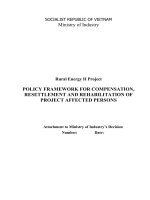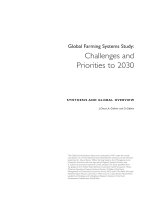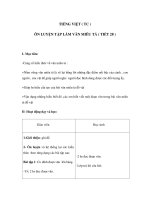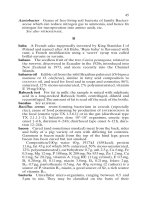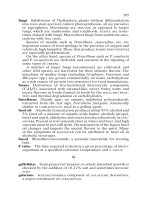Tài liệu GLOBAL SURVEY ON INTERNET PRIVACY AND FREEDOM OF EXPRESSION docx
Bạn đang xem bản rút gọn của tài liệu. Xem và tải ngay bản đầy đủ của tài liệu tại đây (2.01 MB, 144 trang )
Co
mm
u
ni
cat
i
o
n
a
n
d
Communication and
I
n
fo
rm
at
i
o
n
Sector
Information Sector
U
n
i
te
d
N
at
i
ons
United Nations
Educational, Scientific and
Educational, Scientific and
C
ultural
O
rganization
Cultural Organization
UNESCO
Publishing
United Nations
Educational, Scientific and
Cultural Organization
UNESCO
Publishing
United Nations
Educational, Scientific and
Cultural Organization
UNESCO
Publishing
United Nations
Educational, Scientific and
Cultural Organization
The Changing Legal and Regulatory
Ecology Shaping the Internet
FREEDOM OF CONNECTION
FREEDOM OF EXPRESSION
William H. Dutton • Anna Dopatka • Michael Hills • Ginette Law • Victoria Nash
Global survey on internet privacy and freedom of expression
Toby Mendel • Andrew Puddephatt • Ben Wagner • Dixie Hawtin • Natalia Torres
internet privacy and
freedom of expression
UNESCO SERIES ON INTERNET FREEDOM
UNESCO SERIES ON INTERNET FREEDOM
Communication and Information Sector
United Nations Educational,
Scientific and Cultural Organization
U
NESCO, as enshrined in its Constitution, promotes the “free ow
of ideas by word and image”, and has committed itself to enabling
a free, open and accessible Internet space as part of promoting
comprehensive freedom of expression online and ofine. We hope that this
publication will provide UNESCO Member States and other stakeholders,
national and international, with a useful reference tool. It is our wish that this
publication will contribute to bringing stakeholders together for informed
debate on approaches that are conducive to privacy protection without
compromising freedom of expression. In the coming years, UNESCO will
specically seek to disseminate information about good practices and
international collaboration concerning the points of intersection between
freedom of expression and privacy. Research on safeguarding the principle
of freedom of expression in Internet policy across a range of issues will
continue to be part of UNESCO’s normative mandate and technical advice
to stakeholders.
Jānis Kārkliņš
Assistant Director-General for Communication and Information, UNESCO
Toby Mendel • Andrew Puddephatt • Ben Wagner • Dixie Hawtin • Natalia Torres
Toby Mendel • Andrew Puddephatt • Ben Wagner • Dixie Hawtin • Natalia Torres
INTERNET PRIVACY AND
FREEDOM OF EXPRESSION
UNESCO SEriES ON iNtErNEt FrEEdOm
Authors
•
AndrewPuddephatt,Director,GlobalPartners&Associates
• TobyMendel,ExecutiveDirector,CentreforLawandDemocracy
• BenWagner,Researcher,EuropeanUniversityInstitute
• DixieHawtin,ProjectManager,GlobalPartners&Associates
• NataliaTorres,Researcher,CenterforStudiesonFreedomofExpressionandAccess
toInformation(CELE)oftheUniversityofPalermo,Argentina
Advisory Board
•
EduardoBertoni,Director,CenterforStudiesonFreedomofExpressionandAccess
toInformation(CELE),UniversityofPalermo,Argentina
• GamalEid,Director,ArabicNetworkforHumanRightsInformation,Egypt
• SinfahTunsarawuth,Independentmedialawyer,Thailand
• SunilAbraham,DirectorofCentrefortheInternetandSociety,India
• GraceGithaiga,IndependentresearcherandKictanet,Kenya
• JoeMcNamee,AdvocacyCoordinator,EuropeanDigitalRights
• Katitza Rodriguez, International Rights Director, Electronic Frontier Foundation,
UnitedStatesofAmerica
• Cynthia Wong, Attorney, Center for Democracy and Technology, United States of
America
With special thanks to the following who kindly agreed to be interviewed for this publication:
GuoLiang,YangWang,CerenUnal,AngPengHwa,ErickIriarteAhon,KatitzaRodriguez,
KarenReilly,AliG.Ravi,MoezChackchouk,PrimaveradeFilippi,PeterParycek,Robert
Bodle, SameerPadania, Peter Bradwell,UlrikeHöppner,EduardoBertoni,Hong Xue,
Monique Fanjoy, Abu Bakar Munir, Joe McNamee, Amr Gharbeia, Jamie Horsley,
NepomucenoMalaluan,CynthiaM.Wong,SinfahTunsarawuth,PrimOtvanDaalen,Sunil
Abraham,andanumberofanonymousformeremployeesoflargetechnologycompanies.
Publishedin2012by
theUnitedNationsEducational,
ScienticandCulturalOrganization
7,placedeFontenoy,75352Paris07SP,France
©UNESCO2012
Allrightsreserved
ISBN978-92-3-104241-6
Thedesignationsemployedandthepresentationofmaterialthroughoutthispublicationdonotimplythe
expressionofanyopinionwhatsoeveronthepartofUNESCOconcerningthelegalstatusofanycountry,
territory,cityorareaorofitsauthorities,orconcerningthedelimitationofitsfrontiersorboundaries.
Theideasandopinionsexpressedinthispublicationarethoseoftheauthors;theyarenotnecessarily
thoseofUNESCOanddonotcommittheOrganization.
TypesetandprintedbyUNESCO
ThispublicationwasrstprintedthankstothecontributionoftheSwedishInternationalDevelopment
CooperationAgency(Sida)
Printed in France
CONTENTS
FOREWORD 5
EXECUTIVE SUMMARY 7
1. INTRODUCTION 9
1.1 How has the Internet changed the nature of threats to privacy?
What are the main threats in the digital age? 12
1.1.1 New types of personal information 14
1.1.2 Collection and location of personal information 14
1.1.3 New capacities for private actors to analyse personal information 15
1.1.4 New capacities for governments to analyse personal information 17
1.1.5 New opportunities for commercial use of personal data 19
2. GLOBAL OVERVIEW OF CHALLENGES AND OPPORTUNITIES
FOR PRIVACY PROTECTION ON THE INTERNET 22
2.1 Key issues 22
2.1.1 Challenges and opportunities for maintaining control over personal data online 22
2.1.2 Initiatives to protect privacy and anonymity online 24
2.1.3 The roles and responsibilities of service providers and intermediaries 26
2.2.1 Cloud computing 29
2.2.2 Search engines 31
2.2.3 Social networks 33
2.3 Threats posed by different mechanisms of surveillance and data collection 39
2.3.3 Deep packet inspection (DPI) 42
2.3.4 Pervasive geo-location technology: an emerging threat to Internet privacy 44
2.3.5 Data processing and facial recognition 45
2.3.6 Internet surveillance technology 47
3. THE GLOBAL LEGAL AND REGULATORY ENVIRONMENT
3.1 International protection for privacy and personal data 52
3.1.1 Privacy 52
3.1.2 Data protection 63
3.2 National protection for privacy 74
3.2.1 China 74
3.2.2 India 78
3.2.4 France 81
3.2.5 Argentina 84
3.2.6 Mexico 85
3.2.7 United States of America 87
3.2.9 South Africa 91
3.3 Corporate initiatives 92
AND FREEDOM OF EXPRESSION 95
4.1 The impact of poor protection for privacy on freedom of expression 95
4.2 Tensions between freedom of expression and privacy 97
4.2.1 The public interest 98
5.2 Corporate policy and practice 112
5.3 Awareness raising 115
6. USEFUL RESOURCES 117
6.1 General 117
6.3 Arab states 121
6.5 Latin America and the Caribbean 124
6.6 Europe and North America 125
6.7 Gender 127
BIBLIOGRAPHY 129
INTERVIEWS 138
APPENDIX 2: LIST OF FIGURES AND BOXES 142
5
FOREWORD
UNESCO,asenshrinedinitsConstitution,promotesthe“freeowofideasbywordand
image”,andhascommitteditselftoenablingafree,openandaccessibleInternetspace
aspartofpromotingcomprehensivefreedomofexpressiononlineandofine.
Asdemonstratedby UNESCO’s2011publicationFreedom of Expression: Freedom of
Connection, the Changing Legal and Regulatory Ecology Shaping the Internet,freedom
is not the inevitable by-product of technical change, and it must be safeguarded by
appropriatelegalandregulatorymeasures.Atatimeofrapidchange,wearefullyaware
thatfreedomofexpressiononInternetiscomplex,andthatthismeansworkingtond
a balancebetween this rightand other, sometimes conicting,imperatives – suchas
nationalsecurity,protectionofauthors’rights,andrespectforprivacy.
UNESCO approaches these issues within the framework of the follow-up process to
the World Summit of Information Society and our activities in relation to the Internet
GovernanceForum.
WeknowwellthatwenowliveinaworldwithtwobillionInternetusersandvebillion
mobilephoneusers,whoarepostingmillionsofpublicblogs,tweets,images,podcasts,
aswellastheirpersonalinformationondailybasis.
Inthiscontext,UNESCOhasrecognisedthatprivacy,asafundamentalright,impactson
otherrightsandfreedoms,includingfreedomofexpression,associationandbelief.The
challengeisthatmechanismstoprotectonlineprivacycansometimesbeusedtoinfringe
legitimatefreedomofexpressionin generalandthe democraticrolesofjournalismin
particular. Anadditionalchallenge inbalancing these rightson theInternetlies in the
discrepancyofthelegalframeworksbetweenonlineandoff-lineterritories,aswellas
nationalandinternationaljurisdictions.
Withallthisinmind,thispublicationseekstoidentifytherelationshipbetweenfreedom
ofexpressionandInternetprivacy,assessingwheretheysupportorcompetewitheach
other in different circumstances. The publication maps out the issues in the current
regulatorylandscapeofInternetprivacyfromtheviewpointoffreedomofexpression.It
providesanoverviewoflegalprotection,self-regulatoryguidelines,normativechallenges,
andcasestudiesrelatingtothetopic.
Providing up-to-date and sharp information on emerging issues relevant to both
developedanddevelopingcountries,wehopethatthispublicationwillprovideUNESCO
MemberStatesandotherstakeholders,nationalandinternational,withausefulreference
tool.Multiplestakeholders,preferablyindialogue,canusethispublicationintheirown
spheres of operation, adapting where appropriate from the range of experiences as
recordedinthesepages.Thepublicationalsosuppliesadditionalsourcesofreferencefor
interestedreaderstousetofurtherinvestigateeachofthesubjectshighlighted.
Itisourwishthatthispublication willcontributetobringingstakeholderstogetherfor
informed debate on approaches that are conducive to privacy protection without
compromising freedom of expression. In the coming years, UNESCO will specically
6
seek to disseminate information about good practices and international collaboration
concerning the points of intersection between freedom of expression and privacy.
ResearchonsafeguardingtheprincipleoffreedomofexpressioninInternetpolicyacross
arangeofissueswillcontinuetobepartofUNESCO’snormativemandateandtechnical
advicetostakeholders.
Jānis Kārkliņš
Assistant Director-General
for Communication and Information
UNESCO
7
EXECUTIVE SUMMARY
Privacyisafundamentalright,eventhoughitisdifculttodeneexactlywhatthatright
entails.Privacycanberegardedas havinga dualaspect –it isconcernedwithwhat
informationorsideofourliveswecankeepprivate;andalsowiththewaysinwhichthird
partiesdealwiththeinformationthattheyhold–whetheritissafeguarded,shared,who
hasaccessandunderwhatconditions.
Understandingsofprivacyhavelongbeenshapedbythetechnologies available,with
earlyconcernsaboutprivacysurfacingwithnewspapersinthenineteenthcentury.So
theInternet,inturn,inevitablyreshapeswhatweunderstandprivacytobeinthemodern
world.
Therighttoprivacyunderpinsotherrightsandfreedoms,includingfreedomofexpression,
associationand belief.Theabilitytocommunicateanonymouslywithoutgovernments
knowingouridentity,forinstance,hashistoricallyplayedanimportantroleinsafeguarding
free expression and strengthening political accountability, with people more likely to
speakoutonissuesofpublicinterestiftheycandosowithoutfearofreprisal.Atthe
sametime,therighttoprivacycanalsocompetewiththerighttofreedomofexpression,
andinpracticea balancebetweentheserights iscalledfor.Strikingthis balanceisa
delicatetask,andnotonethatcaneasilybeanticipatedinadvance.Forthisreasonithas
longbeenaconcernofthecourtstomanagethisrelationship.
TheInternetpresents signicantnew challengesfor protectingtheright toprivacy.In
broadterms,theInternet:
• Enablesthecollectionofnewtypesofpersonalinformation–technologicaladvances
haveresultedintoolsforcollectingandunderstandingtypesofinformationwhichin
thepastwouldhavebeenimpossibleorunfeasible.
• Facilitates the collection and location of personal information – each computer,
mobilephoneorotherdeviceattachedtotheInternethasauniqueIPaddress,which
providesuniqueidentierforeverydeviceandwhichmeansinturnthattheycanbe
traced.Theabilitytolocateanydevicecreatessignicantnewprivacychallenges.
• Creates new capacities for government and private actors to analyse personal
information.Increasedcomputingpowermeansthatvastquantitiesofinformation,
once collected,can be cheaplyandefciently stored,consolidated and analysed.
Technological advances allow databases of information to be connected together
allowingevengreaterquantitiesofdatatobeprocessed.
• Createsnewopportunitiesforcommercialuseofpersonaldata.Manyoftheservices
providedbythesecompaniesarefreeandtheirbusinessmodelsrelyoncollecting
userinformationandusingitformarketingpurposes.
• CreatesnewchallengesforregulationgiventhetransnationalnatureoftheInternet.
Despitetheemergenceofinternationalbestpracticestandardsfordataprotection,
thereisstillmuchprogresstobemadetowardstheharmonisationofnationallaws.
Online companies still nd it hard to navigate the complex patchworkofnational
8
privacy laws when operating international Internet services that span national
boundaries,withlegalambiguityunderminingprivacyprotection.
ArangeofthreatstoprivacywhichhavedevelopedthroughtheInternetareconsideredin
moredetailinSection2ofthepaper.Thefollowingissuesareexplored:
(1) Theopportunitiesandchallengesformaintainingcontroloverpersonaldataonline.
(2) Arangeofinitiativestoprotectprivacyandanonymityonline.
(3) Therolesandresponsibilitiesofserviceprovidersandintermediaries.
(4) Thespecicchallengesposedbydifferentapplications,communicationsplatforms
and businessmodelsincluding cloud computing,searchengines,social networks
andotherdifferentdevices.
(5) Theproblemsposedbye-governmentandothergovernmentapproaches.
(6) Thethreatsposedbydifferentmechanismsofsurveillanceanddatacollectionincluding:
Unique Identiers; Cookies (and other associated forms of user identication);
Adware;SpywareandMalwareconductcovertdataloggingandsurveillance;Deep
packetinspection(DPI);anddataprocessingandfacialrecognitionandsurveillance
technology.
International legalstandardsonprivacy,andresponsestotheseemergingissues,are
exploredinSection3.Thesectionsetsouttheexplicitunderstandingsandprotections
fortherighttoprivacyunderinternationalhumanrightslaw.Thesectionthenanalyses
keylegislationandregulatoryframeworksthatimpactontheprotectionofprivacyrights
onlineattheregionalandnationallevelincountriesacrosstheworld;andfurthermore
analysesthestrengthsandweaknessesofself-regulationasaprivacyprotectiontool–
whetheritbeusedasacentralmechanism,orsupplementarytolegalprotections.
Therightstoprivacyandfreedomofexpressionrelatetoeachotherincomplexways
– Section 4 explores these intersections in greater detail. In some ways privacy is a
necessarypreconditionforfreedomofexpression–thisisespeciallytrueincountries
whereitmaybedangeroustodiscusscertainissues(suchaspolitics,religionorsexuality)
openly.Howevertherearealsosignicanttensionsbetweenthetworights,forexample
whereanewspaperwishestopublishprivatedetailsaboutaleadingpolitician,perhaps
becausethenewspaperbelievesthisisinthepublicinterest.Thesetensionshavecome
intofargreaterprominencewiththemassivechangesinfreedomofexpressionbrought
aboutbytheInternetandotherdigitalcommunicationssystems.
The paper explores international law and the practice of other States, in terms of
respecting privacy on the Internet, taking into account potential conicts with other
rights,inparticularfreedomofexpression.Section5containsourrecommendationsto
statesandcorporationsforbetterpracticebasedonourresearchandconsultations.The
recommendationscover: legal andregulatorymeasures(constitutionalmeasures,civil
lawprotection,criminallawprotection,dataprotectionsystems),corporatepolicyand
practiceandawarenessraising.
Finally,Section6providesanoverviewofliterature,backgroundmaterialandtoolson
internationalandnationalpolicyandpracticeonprivacyandfreedomofexpressionon
theInternet.Thissectionisintendedasaresourceforreaderswhowishtoaccessfurther
instruments,toolsandinformation.
9
1. INTRODUCTION
Theneed forprivacyis deep-rootedin humanbeings.In itsessentialform, privacyis
basedonthenotionofpersonalintegrityanddignity.However,thisisalsohardtodene
with any agreedprecision – indifferent contexts it embraces the right to freedom of
thoughtandconscience,therighttobealone,therighttocontrolone’sownbody,the
righttoprotectyourreputation,therighttoafamilylife,therighttoasexualityofyourown
denition.Inadditionthesemeaningsvaryfromcontexttocontext.Despiteitsubiquity
thereisnoonedenitionofprivacythatisuniversallyunderstoodinthesameway.Privacy
inthemodernworldhastwodimensions–rstly,issuestodowiththeidentityofaperson
andsecondly,thewaytheirpersonalinformationishandled.
Understandingsofprivacyhavelongbeenshapedbyavailabletechnologies.Atthemost
obviouslevelprivacyinvolvesrestrictinginvasionsofphysicalspace,andtheprotection
of home and personal possessions, which is why early privacy protections focused
upon the inviolability of the home and family life. Concerns about controlling what
informationisknownaboutapersoncamewithcommunicationtechnologies.Concerns
abouttheerosionofprivacyarenotnew–infact,itmightbearguedtheyarefeatureof
thetwentiethcentury.WarrenandBrandeis’ seminalpaper on“TheRight toPrivacy”
in 1890, draftedata time when newspapers were printing pictures of peopleforthe
rsttime,denedtherightasthe“righttobeleftalone”.Theirdenition–drivenbyan
emergingtechnologyasisoftenthecasewithprivacy–wasconcernedwithprotecting
the“inviolatepersonality”andencompassingsuchvaluesasindividualdignity,personal
autonomyandindependence.
1
Thegrowthofmodernmassmediaandtheadvertising
industry’sfocusonunderstandingconsumers’wantsledMyronBrentontoarguethatwe
arelivinginthe“ageofthegoldshbowl”,whereprivatelivesaremadepublicproperty
bythemanipulationandexchangeofpersonaldata.
2
Thereisatensionbetweentherighttofreedomofexpression–inparticularthemedia’s
exerciseoftheright–andtherighttoprivacy.Freedomofexpression,whetherexercised
byindividualsorbythemedia,andtheabilitytoexerciseit,isanessentialfeatureofany
open,liberalanddemocraticsociety.Itisonlythroughexercisingfreeexpressionthat
societies cansustainreal democraticaccountability.Howeverthe right tofreedom of
expressionisnotunlimitedanditcanbequaliedtoprotecttherightsandfreedomsof
others.Itisadelicatebalancetodecidewheretheboundarybetweenfreeexpression
andprivacyliesbutonethecourtsareusedtonegotiating.
Latterly,privacywasalsodenedastherightofpeopletodeterminewhen,howandto
whatextentinformationabout themiscommunicatedto others
3
asaresponseto the
growingprocessingpowerofcomputers.Privacy,accordingtoWestin“istheclaimof
individuals,groups,orinstitutionstodetermineforthemselveswhen,how,andtowhat
extentinformationaboutthemiscommunicatedtoothers [Itis]thedesireofpeopleto
1 Bloustein, E. (1964) Privacy as an aspect of human dignity: an answer to Dean Prosser 39 NYU L
Rev 962
2 Brenton, M (1964) The Privacy Invaders
3 Westin AF (1967) Privacy and Freedom New York: Atheneum, page 7
10
choosefreelyunderwhatcircumstancesandtowhatextenttheywillexposethemselves,
theirattitudesandtheirbehaviourstoothers”.
4
Thespecicdimensionaffectingprivacy
asbroughtbytheInternetisconsideredinmoredetailinSection2Globaloverviewof
challengesandopportunitiesforprivacyprotectionontheInternet.
Debatesaboutprivacyand informationtechnologies sincethe 1990shave takenlittle
account of gender. Concerns have been expressed about the potential of invasive
informational technologies to violate women’s privacy for sexual purposes and the
“enforcedprivacy”imposedbypatriarchalculturesuponwomenandgirls.Neitherofthese
arecentraltotheprivacyissuesdiscussedinthispaperortotheexerciseofprivacyrights
asdevelopedinthelatersections.Forthisreasonourpaperreferstopeoplethroughout
ratherthandistinguishingbetweenwomenandmen,aswebelievethatprivacyrightsare
universalandapplicabletobothwomenandmenonanequalbasis.
Just asthe notionsofprivacy haveshiftedwith changingcircumstances,early forms
oflegal protectionwerenot overarchingsystems toprotectprivacy butrathersought
toaddressspecicproblemsinspeciccontextsandsituations(whichtodaymightbe
viewedasaspectsofthegeneralrighttoprivacy).Oneearlyexampleofsuch“privacy”
legislationwasEngland’sJusticesofthePeaceActof1361.Itprovidedforthearrest
of “peeping toms” and eavesdroppers.
5
The pioneering Entick v Carrington [1765]
casewhichshapedthe fourthamendmentoftheUSconstitutioncame fromadesire
toprotectpapersheldinaprivatehome.Otherexamplesfocuseduponthepurposes
forwhichgovernmentscouldusetheinformationtheyheldaboutindividuals(Sweden)
orprohibitionsonthepublicationofcertaintypesofpersonalinformation(Franceand
Norway).
6
Inthetwentiethcenturyinternationallegalstandardsdenedprivacyasahumanright.
TheUniversalDeclarationofHumanRights(UDHR),1948,containedtherstattemptto
protectprivacyasadistincthumanright.Article12oftheUDHRprovidesthat:
“Nooneshallbesubjectedtoarbitraryinterferencewithhisprivacy,family,
homeorcorrespondence,nortoattacksuponhishonourandreputation.
Everyonehastherighttotheprotectionofthelawagainstsuchinterference
orattacks.”
While not legally binding, the UDHR proved immensely authoritative and the right to
privacycanbefoundinmanyotherhumanrightsdocumentsincludingthelegallybinding
InternationalCovenantonCivilandPoliticalRights(ICCPR)andtheEuropeanConvention
onHumanRights(ECHR).ThesearedealtwithinmoredetailinSection3dealingwith
legalstandards,TheGlobalLegalandRegulatoryEnvironmentforProtectionofPrivacy.
In addition to these broad international provisions, many countries include a right
toprivacyin theirconstitutions, provide forit inspecic lawsor havehadthecourts
recogniseimplicitconstitutionalrightstoprivacy,astheydoinCanada,France,Germany,
4 Ibid
5 Beresford A. and Stajano F. (2003) Location Privacy in Pervasive Computing, IEEE Communications
Society
6 Privacy International, (2006) Privacy and Human Rights 2006: An International Survey of Privacy
Laws and Developments
11
Japan,andIndia.
7
Somecensusagencieshaveprivacypoliciestoensuretheprotection
ofpersonalinformationbeingcollected.
8
Despitetheextensiveprotectionsinbothbasicconstitutionsandlaw,therighttoprivacy
remainsasomewhat nebulous concept andsecuringthe right willdependlargely on
thecircumstancesof individualcases.The EuropeanCourthasstateditself that“the
Courtdoesnotconsideritpossibleornecessarytoattemptanexhaustivedenitionof
thenotionof‘privatelife’”.
9
Thelackofclarityhas ledonecommentatortostatethat
the fact that something “feels wrong is often the most helpful delineation between
whenanincursionintotheprivatelifeofanindividualisreasonableandwhenitisnot”.
10
PrivacyInternationalhasattemptedtobringsomeclaritytotheissuebydeningfour
differenttypesofprivacy: informationprivacy (e.g.personaldata),bodilyprivacy(e.g.
invasiveprocedures),privacyofcommunication(e.g.surveillance)andterritorialprivacy
(e.g.home).
11
InrelationtotheInternet,informationprivacyandprivacyofcommunication
arethemostpertinent.
Theimportancegiventoprivacybymanylegislatorsandthinkersinhistoryindicatesits
signicance, however,asPaul Chadwick(information commissioner forthe Australian
State ofVictoria) putsit:“Privacy is the quietestofour freedoms Privacyis easily
drownedoutinpublicpolicydebates Privacyismostappreciatedbyitsabsence,notits
presence”.
12
Thevalueofprivacyhasbeenarticulatedintermsofvaluetotheindividual,it
isessentialtohumandignityandindeedtoindividuality,itissaidthatifallouractionsare
watchedandcatalogued,wearelessabletobeourselves.Thevalueofprivacyhasalso
beenarticulatedintermsofitsinstrumentality.Democracyandlibertyrelyonindividuals
havingacertaindegreeofprivacy.Therighttoprivacyunderpinsmanyhumanrights,
therighttofreedomofassociation,freedomofbeliefandfreedomofexpressionbeing
particularlysignicantexamples.Asonewriterputsit“inonesense,allhumanrightsare
aspectsoftherighttoprivacy”,
13
inthatifprivacyisprotectedthentheintegrityofthe
individualisassuredandthisisthefoundationofotherrightsandfreedomsdesignedto
protectthedignityoftheperson.
Howeveritshouldalsobenotedthatwhilepeopleareoftenconcernedaboutprivacy
intheabstract,theyseemlessconcernedaboutprivacyinpractice.Itisclearfroma
cursory use of the Internet that people give out personal information to a frequently
surprising degree.Manywriters havenoticedthe gapbetweenwhat peoplesaythey
valueandwhattheyactuallydoonline.ItmaybethenatureoftheInternet,whichisoften
accessedprivatelyandcombinesbothacommunicationmediumintheshapeofe-mail
(whichmaysuggesttotheusertheprivacyofthetelephonecallorprivateconversation)
andapublishingmediumaswithanapplicationlikeFacebook.Thereissomeanecdotal
evidencethatpeopledonotrealisetheimplicationsofpublishingonline,ofhowitwillbe
7 Solove, D.J. (2008) Understanding Privacy Harvard University Press
8 United States Census Bureau, Data Protection and Privacy Policy
9 Niemietz v Germany (1992), 16 EHRR 97. Para 29
10 Hosein, G. (2006) ”Privacy as freedom” in R. Jorgensen (ed.) “Human Rights in the Global
Information Society” MIT Press, Cambridge.
11 Privacy International, 2006.
12 Ibid. Page 2
13 Volio, F. “Legal Personality, Privacy and the Family” in Henkin (ed), The International Bill of Rights
(Columbia University Press 1981).
12
globallyavailableandundeletable.Forexample,57%ofUSadultswhousetheInternet
athomebelieveincorrectlythatwhenawebsitehasaprivacypolicy,itwillnotsharetheir
personalinformationwithotherwebsitesorcompanies.
14
1.1 How has the Internet changed the nature of threats to
privacy? What are the main threats in the digital age?
Internet access is expanding rapidly across most of the world. Statistics from the
ITU,Figure1,showthatbetween2005and2010alone, thenumberofInternetusers
doubled. In1995only 0.4% oftheworld’spopulationhad access totheInternet,by
March2011 that percentagehaderupted to30.2%.
15
Thiscorresponds tomore than
two billion Internet users, 1.2billionof whom areindeveloped countries. The rise in
usageofmobilephoneshasbeenevenmoreextraordinary.Figure2showsthenumberof
mobilesubscriptionsbetween1998and2009.Todaythereare5.3billionmobilecellular
subscriptionsworldwide.Accesstomobilenetworksisavailableto90%oftheworld’s
population,andsomecommentatorsbelievethatuniversalavailabilitymaybeachieved
withinthenextveyears.
16
Indevelopedcountriestherearemoremobilesubscriptions
thantherearepeople(113.6subscriptionsper100inhabitants),andwhilethenumberis
muchlowerindevelopingcountries,itisstillveryhigh,with56.8subscriptionsper100
inhabitants.
17
Figure 1
18
Internet users in different regions
0
0,5
1
1,5
2
2,5
2005 2006 2007 2008 2009 2010
BillionsofInternet
users
Africa10.8
ArabStates24.1
CIS34.0
Europe67.2
TheAmericas50.7
Asia&Pacific22.5
14 Turow, J. Americans and Online Privacy: The System is Broken
15 Internet World Statistics
16 See e.g. Sarrazin, T. (2011) Texting, Tweeting, Mobile Internet
17 ITU World Telecommunication, 2010a. The World in 2010. Pg4. [online]
/>18 ITU World Telecommunication, 2010. Pg16.
13
Figure 2
19
0
20
40
60
80
100
120
2000 2001 2002 2003 2004 2005 2006 2007 2008 2009 2010
Developed
Developing
World
ThecombinationofInternetandmobilephonehascreatedafastmovingglobaldigital
communicationsenvironment.ThoughonlyaproportionofphonesareInternet-enabled
andanevensmallerproportionare“smart”,thisischangingrapidlyandinthenextveto
tenyearsmostobserversthinkthataccesstosuchphoneswillbeverywide.Whilethere
werethreatstoprivacylongbeforethedigitalage,thecurrentchallengeshavechanged
signicantlyastheInternethasincreasedthecapabilitiesofgovernments,businesses
andindividualstointrudeontheprivacyofothers.Manycommentatorsnotethatmuch
oftheprivacywepossessedinthepastarosefromdefault–thedifcultiesinvolvedin
monitoringpeopleweretoocomplexorexpensive,technologycouldnotcopeandthere
wasinsufcientortooexpensivemanpower.WiththedevelopmentoftheInternetand
theavailabilityofcheapinteractivedigitalcommunicationstheabilitytomonitorothers
hasbecomeeasier,cheaperandmoreefcient.TheInternethasenormouslyincreased
thepotentialimpactupontheprivacyrightsapersonhasinboththeiridentityandthe
treatmentoftheirpersonaldata.Internetuseandtransactionsgeneratealargeamount
ofpersonalinformationwhichiscentraltothebusinessmodelofcompaniesoperatingon
thenet–howtheseareunderstood,letaloneregulated,inafastchangingtransnational
environmentisamajorchallengeforpolicymakers.
Inbroadterms,theInternet:
• Enablesthecollectionofnewtypesofpersonalinformation
• Facilitates (and economically demands) the collection and location of personal
information
• Creates new capacities for government and private actors to analyse personal
information
• Createsnewopportunitiesforcommercialuseofpersonaldata
• CreatesnewchallengesforregulationgiventhetransnationalnatureoftheInternet.
Weexaminethemoredetailedimplicationsforeachoftheseissuesbelow.
19 ITU World Telecommunication, 2010. Pg16.
14
1.1.1 New types of personal information
Technological advances have developed the tools for collecting and understanding
typesofinformationwhichinthepastwouldhavebeenimpossibleorelseunfeasible.
For example, DNA’s role inheredity was only conrmed in the 1950s, but nowadays
progressingeneticsciencesallowsscientiststoextractaperson’sDNAfromevermore
minutesamples,andtodetermineevermoreaboutan individualfromtheirDNA.The
digitalstorageofDNAisanenormousadvantageinattemptstodealwithcrimeasithas
enabledanumberofcoldcasemurderstoberevisitedandatthesametimehasledtothe
freeingofanumberofinnocentpeoplewronglyconvictedofcrimes.Buttheretentionof
DNAhassignicantprivacyimplications(amongotherissues)asitcancontainavariety
ofsensitivepersonalinformation,suchasapredispositiontocertaindiseases.
Therearesignicantnewdevelopmentsinbiometrics,suchasfacialrecognition,nger
scanning andiris-scanning, whicharebecoming increasinglypopular asamethod to
secureidentication.Suchbiometricdeviceshaveawidevarietyofuses–theyareused
to prevent fraud by retailers andrestaurant owners,toidentify voters in elections, to
provideimmigrationaccess(ratherthanuseapassport),tomaintainattendancerecords
inworkplacesortogainaccesstohigh-securityareas.Whilethereisagreatdealofsocial
utility intheseapplications thereare concerns aboutthecontrol ofsuch digital data,
particularlyquestions ofstorageandaccess.Therehas beenaparticularcontroversy
aboutwholebodyimagingusedatairportsfollowingattemptsbyterroriststosmuggle
bombson planesinsidetheirclothing.Many travellersdisliketheuseof technologies
whichpenetrateclothingandproducewhatisessentiallyanudeimageofanindividual
which is viewed by others. Many nd this to be an invasion of their privacy. These
imagescanrevealdeeplypersonalinformationsuchasthefactthatanindividualhas
hadcosmeticsurgeryorusescolostomybagsbutinanycasemanypeopleregardtheir
clothingasanessentialpartoftheirbodilyprivacy.Againsttheseprivacyconcernsmust
bebalancedthesafetyofpassengersofcoursebutinthesefastmovingcircumstances
strikingtherightbalanceisfraughtwithdifculties.
1.1.2 Collection and location of personal information
Each computer, mobile phone or other device attached to the Internet has a unique
IPaddress,whichprovidesuniqueidentierforeverydeviceandwhichmeansinturn
thattheycanbetraced.Theabilitytolocateanydevicecreatessignicantnewprivacy
challenges. Of the many tools that have been created to track Internet users, two
commonexamplesarecookiesandwebbugs.Cookiesaresmallpiecesoftextwhich
webbrowsersstoreonauser’scomputer.Thecookie‘registers’withthewebbrowser
eachtimetheuseraccessesthatbrowserandcanbeusedforsessiontracking,storing
sitepreferences,authenticationetc.Userscandecidewhetherornottoacceptcookies
bychangingsettingsontheirbrowsersoftware,butsomesitesbecomeunusablewithout
them.Webbugsareusuallyinvisibletotheuser(theyaretypicallyonly1x1pixelinsize)
andareembeddedinwebpagesandemails.Whenthepage/emailcontainingtheweb
bugisviewed,itsendsinformationbacktotheserver(includingtheIPaddressofthe
user,thetimeanddatethatthepage/emailwasviewedandthebrowseritwasviewed
on).
AnIPaddresscanbetiedtoaperson’sphysicalidentityinmanyways.Manywebsites
and ISPs have developed authentication systems which involve identity disclosure
15
(particularly during electronic commercial transactions); many applications require
personale-mailorotherformsofidentication,governmentsmayrequireInternetusers
to register theirIP addresses,or identity canevensometimes bededucedthrougha
person’sonlineactions(seebelow).
AkeyfeatureoftheInternetisitsinteractivitywhencomparedwith“old”technologies
such as the television, radio and telephones. Users are often required to provide
informationaboutthemselveseverystepoftheway–forexample,whatsearchesthey
make, what links they click on, what pages they look at and for how long. A series
of technologicaltoolsand devices are designedtocollect this information(e.g.TiVo,
Xbox360,GoogleBooks).
20
ThisisacentralpartoftheeconomicmodeloftheInternet.
Thedigitalisationofinformationandexpectationoffreeaccessmakestraditionalforms
of income generationmore complexonthe Internet.Successful companies therefore
consciously“mine”personaldatainordertotargetadvertisingatusers.Thereistherefore
adirectandpowerfuleconomicincentivetosecure,retainandsharepersonaldata.This
alsoappliestonon-Internetelectronicactivity.Computerisedbarcodescanbeusedto
trackindividualpurchaseswhichinturnarethenusedtocontrolstocklevelsandtarget
incentives or marketing at those consumers.Computerisedtravelcards, such as the
LondonOystercard,createadigitalpictureofeveryjourneythatcanbeusedtomonitor
citywidepassengermovements–usefulfortransportplanning,butalsofortrackingan
individual’sjourneys.Asthe Internetis used in moreandmore everyday interactions
includingbanking,shoppingandsocialisingpeoplearegivingawaymoreandmoreof
theirpersonaldata,oftenunwittinglyincludingsensitiveinformationabouttheirnances,
heath and eventheirsexuality. These developments allowanever greater amount of
informationtobegatheredand,asLawrenceLessigpointedout,“yourlifebecomesan
ever-increasingrecord”.
21
Watching and locating people ofine has also become much easier using electronic
surveillance.CCTVcamerasandsatellitesareusedtomonitorpublicandprivatespaces,
andareavailabletomoreandmorepeople.Locationalinformationisnowextraordinarily
cheapthroughprivateinitiativessuchasGoogleEarth.GlobalPositioningSystems(GPS)
areincorporatedintomoreandmoreconsumerdevices.Radio-FrequencyIdentication
(RFID)tagsareanotherexample.SuchRFIDtagshavebeenexpensive,butpricesare
fallingandultimatelytheycouldidentify,forexample,notonlytheproductthataconsumer
buysbuthowoftenitisusedandwhere.
22
1.1.3 New capacities for private actors to analyse personal information
Increasedcomputingpowermeansthatvastquantitiesofinformation,oncecollected,
canbecheaplyandefcientlystored,consolidatedandanalysed.Technologicaladvances
allowdatabasesofinformationtobeconnectedtogetherallowingevengreaterquantities
ofdatatobeprocessed.Thepotentialforprivacyviolationsincreasesexponentiallyas
technologiesarecombinedtogether,forexample,linkingfacialrecognitiondatabases(as
usedonFacebookforexample)withCCTVcameraswouldallowtrackingofindividuals
onanunprecedentedscale.
20 Privacy International, 2006
21 Lessig, L. (1999) “Code and the Laws of Cyberspace” Basic Books, New York. Page 152.
22 Martínez-Cabrera, A. (2010) Privacy concerns grow with the use of RFID tags ate.
com/cgi-bin/article.cgi?f=/c/a/2010/09/05/BUCE1F8C1G.DTL
16
Thepracticeofmergingandconsolidatingdifferentinformationaldatabasesispervasive.
Privacyissuesclearlyarisefrommatchingdatafromdifferentsources,forexampletax
dataagainsthealthdataornancedataagainstsocialsecuritydata.Inadditionpersonal
data can be extracted from the various techniques and then matched with publicly
availabledatatobuildadetailedpersonalprole.
TheUS-basedprivacyorganisationEPICstatesthat“collectorsofconsumerinformation
arewillingtocategorise,compile,andsellvirtuallyanyitemofinformation”.Forinstance,
the Medical Marketing Service sells lists of persons suffering from various ailments.
Theselistsarecross-referencedwithinformationregardingage,educationallevel,family
dwellingsize,gender,income,lifestyle,maritalstatus,andpresenceofchildren.Thelist
ofailmentsincludes:diabetes,breastcancer,andheartdisease.Othercompaniessell
databasesofinformationrelatingtoindividuals’lifestylehabits,readingpreferences,and
evenreligion”.
23
Combineddatabaseshavenumeroususes. Theycan beusedfordatamining,which
is“theprocessofndingpatternsininformationcontainedinlargedatabases”
24
.Data
miningitselfhasmanyuses,manyofthembenecialsuchastoidentifypatternsindicating
fraudulentcreditcarduse.Whilesomecommentatorsclaimthatdataminingisneutral,
itcanhaveprivacyimplications.Theminingofdataormergingdataofteninvolvesusing
people’sinformationinawaythattheydidnotconsenttoandarenotevenawareof.
Furthermore,thewidearrayofdatadrawnuponoftenincludespersonaldetailsandcan
easilybelinkedtoindividualswithouttheirknowledge.
Anothercommonuseisdataprolingwhichistheuseofaggregateddatato“identify,
segregate, categorise and generally make decisions about individuals known to the
decisionmakeronlythroughtheircomputerisedprole”
25
.Companiesandgovernments
can use data proling to build comprehensive proles on individuals. EPIC give the
exampleof awoman whosuedtheUS-basedMetromailafteroneof theirdataentry
clerksstalked herbasedon informationshesubmitted inasurvey.Duringthecaseit
emerged that Metromail maintained a 25 page dossier on the woman including “her
income,andinformationonwhenshehadusedhaemorrhoidmedicine”.
26
Inordertoprotectprivacy(andcircumventprivacylaws),companiesoftende-identify
oranonymisethedata.Thisisaprocessofstrippingdataofpersonalidentiers(such
asname,socialsecuritynumber,andIPnumber).However,studiesrevealthatitisoften
possibletorelate‘anonymised’informationbacktoanindividual.Forexample,a1990
studyintheUnitedStatesofAmericafoundthatdatacollectedduringacensus(post
code,birthdateandgender)canbecross-referencedtouniquelyidentify87%oftheir
nationalpopulation.
27
Amorerecentexampleoccurredin2006,whenAOLreleaseduser
searchdatawhichwassupposedlynon-identiable;researcherswereconsequentlyable
23 Rotenburg M. And Hoofnagle C. “Submission to the House Government Reform Committee on
Data Mining” March 25, 2003.
24 Fayyad, U., Grinstein, G. and Wierse, A. (2001) “Information Visualization in Data Mining and
Knowledge Discovery”. Morgan Kaufman Publishers.
25 Netter, W. “The Death of Privacy” Privacy Module I: Data Proling Introduction, University of
Harvard, 2002
26 EPIC, “Privacy and Consumer Proling”
27 Sweeney, L. “Strategies for De-Identifying Patient Data for Research” Carnegie Mellon University,
Data Privacy Lab, 1998 Page 26.
17
toidentifymanyusersthroughthenotunusualphenomenaofvanitysearches,wherean
individualsearchestheirownname.
28
Databasescanbeveryhardtoprotect,especiallywheretheycanbeaccessedremotely
and wheremanypeopleare granted access. This leaves personaldataindatabases
vulnerabletoallsortsofcybercriminals.Additionally,informationisoftenreleasedinto
thepublicdomain.Thisisoftenforlegitimatereasons,butcanraiseprivacyconcerns.
Forexample,theWHOISdatabasecontainsthepersonalcontactdetailsoftheindividual
or organisation that registered each domain name. It is released publicly to allow
network administratorsto easily remedy problems onthe Internet.
29
Anotherexample
isthemovement,inmanycountries,toreleasepublicrecordsindigitisedformat.Such
information would have been available previously (such as birth, wedding and death
certicates)butnewformatsmaketheinformationincreasinglymoreaccessibleandeasy
tocross-reference.
30
1.1.4 New capacities for governments to analyse personal information
GovernmentsareattemptingtoharnessthepoweroftheInternetacrosstheirfunctions.
Therehasbeenadramaticmovetowardse-governmentasawayofprovidingmorecost-
effectiveandpersonalisedservices.Asaconsequencemanycountriesareattempting
to streamline and coordinate service provision through developing large databases
containingpersonalinformationaboutcitizens.Identitycards,forexample,areinusein
oneformoranotherinvirtuallyallcountriesoftheworld,andcompulsorynationalidentity
cardsareusedinabout100countries.
31
Increasingly,governmentsaremovingtowards
capturingbiometricdataonthecardsandstoringthisinformationonhugedatabases
whichcanbeusedtocertifyaccessto,andmonitoruseof,forexample,socialsecurity,
healthandtravel.
Thereisaparticularlyimportantroleforthesetechnologiesintheeldofcrimeprevention
and prosecution. Even before the so-called “war on terror” many governments were
makinggreatuseofmonitoringtechnologiessuchasCCTVcamerasforthesereasons.
Since9/11thethreatofterrorismhasactedasadriverinmanycountriesforincreased
useofmonitoringmechanisms,ofteninwayswhichareintrusiveandeveninviolationof
existingprivacylaws.Aparticularlypertinentexampleisthatofairtravel.Asmentioned
above,wholebodyimagingscannersarebeingusedortrialledintheUnitedStatesof
America, the United Kingdom of Great Britain and Northern Ireland, India, Australia,
Japan,theRussianFederation,andtheNetherlandsamongothers.
32
Anotherpractice
hasbeentheuseofsecretwatchlists,forexampleinCanadaandtheUnitedStatesof
28 Soghoian, C. (2007) “The Problem of Anonymous Vanity Searches” Indiana University Bloomington
– School of Informatics. Published online />id=953673 Page 1.
29 EPIC “WHOIS” accessed 15/03/10, published online />30 Privacy International, 2006.
31 Privacy International, 1996, ID Card Frequently Asked Questions vacyinternational.
org/article/id-card-frequently-asked-questions
32 Cavoukian, A. “Whole Body Imaging in Airport Scanners: Building in Privacy by Design” Information
& Privacy Commissioner, Ontario, Canada. June 2009 />wholebodyimaging.pdf Page 2.
18
America.
33
Personaldataissubmittedbytravellersasaconditionoftravellingandthis
informationischeckedagainstdatabasesofuncertainprovenance.Dataprolingisused
tocreatealistofpeoplewhoarejudgedtobeasecuritythreat,thelistiscirculatedto
othercountries,andpeopleonthelistareeitherpreventedfromyingoraresubjected
toenhancedsecuritymeasures.Watchlistssometimesbecomepublic;thishasexposed
errors, but stigmatised individuals; other times they have been kept secret which
has meantthat individuals havebeenrefusedavisa without necessarilyhaving been
convictedofanythingorgiventheopportunitytodefendthemselves.
34
Inonefamous
caseintheUnitedKingdomofGreatBritainandNorthernIreland,aprominentMuslim,
YusufIslam(formerlythesingerknown asCatStevens)waspreventedfromtravelling
totheUnitedStatesofAmerica(hisUnitedAirlinesightfromLondontoWashington’s
DullesInternationalAirportwasdivertedtoBangor,Maine,whenUSofcialsreviewing
thepassengerlistdiscoveredhewasaboard).Therewereallegedlyterroristconnections
reasonsbutthesewerenevermadeexplicit,despitehisrecordasaMuslimwhopromoted
peaceandreconciliationamongcommunities.Subsequentlythebanwaslifted.
Somegovernmentshavebeenabletousethesetechnologiestomonitortheactionsof
theircitizens,particularlydissidents,muchmoreintensively.Forexample,theOpenNet
InitiativereportsthatinChinathemostpopularonlineinstantmessenger(QQ)records
users’onlinecommunicationsandreportsonthesetothepolice.In2006,theChinese
MinistryofPublicSecurityannouncedthelaunchofthe“GoldenShield”project,designed
tobecomeanational systemofadigital surveillance.In2008a Chinesestate-owned
mobilephonecompanyrevealedthatithadunlimitedaccesstoitscustomers’dataand
thatitsuppliesthistotheChinesegovernmentonrequest.Themostglaringexample
ofthiswastheChinesegovernment’sattemptin2009toinsistthatsoftwareknownas
GreenDambebuilt into all personal computers soldinChina.
35
This software would
havemonitoredindividualcomputerbehaviourbyinstallingcomponentsintheoperating
systemandwouldhavegiventheauthoritiesdirectpowertocontrolaccesstocontent
(aswellasallowingremotecontrolofthecomputerrunningthesoftware).
36
Theproposal
wasnallydefeatedthroughtheWTOontradegrounds.Morerecently,therehavebeen
reportsthatChineseauthoritieshavetriedtomakecafes,hotelsandotherbusinessesin
centralBeijinginstallsurveillancetechnologyforthoseusingWi-Fiwhichhasbeenseen
asanotherinstanceoftighteningcontrolsontheuseoftheInternet.
37
The Special Rapporteur on counter-terrorism and human rights has noted examples
ofsurveillance practicesinGermany,Colombia,BangladeshandtheUnitedStates of
America that caused him concern.
38
A 2007 Privacy International study revealed an
overallworseningofprivacyprotectionsandsafeguards,togetherwithanincreaseinthe
occurrenceofsurveillanceacross47countries.
33 Human Rights Council, Thirteenth session, Agenda item 3. 28 December 2009, A/HRC/13/37
Page 17.
34 Ibid.
35 Opennet Initiative, China’s Green Dam: The Implications of Government Control Encroaching
on the Home PC />encroaching-home-pc
36 Wolchok, S.; Yao, R. and Halderman, A. (2009) Analysis of the Green Dam Censorware System
37 Branagan, T. (2011) China boosts internet surveillance />jul/26/china-boosts-internet-surveillance
38 Human Rights Council, 2009, 19, 20
19
CybercrimeisagrowingproblemontheInternetwithestimatesputtingthecostofonline
theftat$1trillion.
39
Laxsecuritymeasuresandsecuritybreachescanresultincriminals
stealingotherpeople’sdatawhichcanthenbeusedtocommitmanycrimessuchas
fraud,theftorstalking.
Finally, surveillance technologies are being used much more locally, to monitor
behaviouroffamilymembersandofemployees.Insteadofmonitoringemployeeswho
exhibitsuspiciousbehaviour,therewasevidencethatmanyemployerswereinstituting
continuoussystematicsurveillanceintheworkplace.
40
Indeedamarketisdevelopingfor
newtechnologiesassistingemployersinmonitoringtheiremployees,asexempliedby
therecentdevelopmentofnewtechnologythatcandetectcomplexemployeebehaviour
andreportbacktotheemployer–thedevicecandifferentiatebetweenactionssuchas
“scrubbing,sweeping,walking,andevenemptyingarubbishbin”.
41
1.1.5 New opportunities for commercial use of personal data
The Internet has generated a vast amount of economic activity. A recent study by
McKinseyestimatesthatthedirectandindirecteconomiceffectsoftheInternetaccount
for3.4%ofGDPinthe13countriesstudiedbut21%oftheeconomicgrowthintheve
matureeconomies,with2.6jobscreatedforeveryjoblost.
42
InternetcompaniessuchasGoogle,YahooandFacebookhaveaccesstoanastronomical
amountofdata.
43
ThebiggestInternetcompanieshavehugeuserbases(forexample,
Facebookhasover800millionusers
44
)andarebranchingouttocovermoreandmore
interactions(forexample,ausermayuseGoogletolocateinformationonline,sendemails,
displayvideos,shopetc.)Manyoftheservicesprovidedbythesecompaniesarefree
andtheirbusinessmodelsrelyoncollectinguserinformationandusingitformarketing
purposes.Userdatathereforehassignicanteconomicvalue.A1999studydiscovered
that92% ofwebsitesweregatheringatleastonetypeofidentifyinginformationfrom
theirusers(forexampletheirname,emailaddressandpostaladdress)
45
anditcanbe
assumedthatsincethengatheringofinformationhasonlyincreased.Companiesalso
haveatendencytobeverysecretiveaboutwhatinformationtheygatherandhow;as
notedinTheEconomist,thisisasmuchtodowithmaintainingacompetitiveedgeasit
iswithprivacyconcerns.
46
39 Weber, T. Cybercrime threat rising sharply, BBC News, 31/01/09 />business/davos/7862549.stm
40 Bonsor, K. Is your workplace tracking your computer activities? stuffworks.
com/workplace-surveillance1.htm
41 Fitzpatrick, M. “Mobile that allows bosses to snoop on staff developed” BBC News 10/03/2010
42 McKinsey Global Institute, (2011) Internet matters: The Net’s sweeping impact on growth, jobs,
and prosperity />internet_matters.pdf
43 Massimino, E. (2012) Privacy, Free Expression And The Facebook Standard bes.
com/sites/realspin/2012/01/31/privacy-free-expression-and-the-facebook-standard/
44 Protalanski, E. (2012) Facebook has over 845 million users />facebook-has-over-845-million-users/8332
45 Federal Trade Commission, (1999) “Self-regulation and Privacy Online: A Report to Congress”
March 1999, Published online at Page 4.
46 Economist, (2010) “Clicking for Gold: How internet companies prot from data on the web”, in “A
special report on managing information” The Economist, Volume 394, Number 8671
20
Much of this economic activity depends upon Internet intermediaries – the range of
actors,servicesandapplicationsthatfacilitatetransactionsbetweenthirdpartiesonthe
Internet,includingforexamplesearchenginesandISPs.Internet-basedcommunications
areincreasinglyreliantontheseintermediariesforaccessing,processingandtransmitting
data.Theincreasingpowerofintermediariesandtheircontroloverpersonaldata,has
given rise to a number of concerns about whether current regulation is sufcient to
protectprivacyrights.Threetypesofintermediariesarouseparticularconcerns–social
networkingsites,cloudcomputingcapacitiesandsearchengines.
Social networking sites
Social networking sites are websites that focus on building and/or reecting social
relationsamongpeople.Somefacilitatevirtual“friendships”withpeoplewhoarealready
knowntothe userofine,allowingthemtosharephotosandconverse online.Others
concentrateonallowingpeopletomakenewfriends,oftenwithaparticularfocussuch
asworkrelations(LinkedIn)ormusictastes(Pandora).Eachserviceisdifferent,butthe
standardformatallowsuserstocreatetheirownwebpagecontainingvariouspiecesof
personalinformation(suchasdateofbirth, location,interests,name).Userscanthen
linktofriendswhowillbeabletoseetheirinformationandviceversa.Socialnetworking
sitesareverypopular,withhundredsofmillionsofusersbetweenthem.Howeverthere
hasbeengrowingconcernoverprivacyviolationscausedbysuchsites.Someconcerns
relate to media and communications literacy, with many users unaware of the risks
involvedinrevealingpersonalinformationtoothers.Manyusersdonotexerciserestraint
aboutwhotheyallowtoseetheirdata,andmanyusersarebelievedtobefriendpeople
thattheydonotknowwell.Thiscanhaveconsiderableimplicationsgiven,forexample,
thatonFacebooktheaverageuserhas130friendsonthesite.
47
Thisisdiscussedinmore
detailinthefollowingsection.
Cloud computing
Cloudcomputingisanemergingnetworkarchitecturewherebydata,processingpower
orsoftwareis storedon remoteservers,asopposedtoanindividual’s computer,and
madeaccessibleviatheInternet.Differentformsofcloudcomputingexistthatprovide
arangeofservices.Individualsororganisationscaneffectivelyrentcomputingcapacity
from remote service providers. For example, Google’s Apps service allows people to
createandsave spreadsheet and word processing documents online.Otherservices
include collaborativeplatformsthat allow usersaccess to documentssimultaneously,
suchaswikiplatformsandGoogledocs.
48
Cloudcomputingcanyieldanumberofpositivebenets.Forexample,itcanreducethe
costsofbuyingandupdatingsoftwareforsmallbusinessesandorganisations,whichcan
beparticularlyempoweringforuserswithlowlevelsofnancialresourcesindeveloping
countries.Itcanalsoimproveconvenienceforusersthroughallowingthemtoaccess
documents anywhereinthe world,and collaborativelyauthordocuments withpeople
workinginothergeographicallocations.
47 Facebook, (2012) “ Statistics” published online
48 EPIC “Cloud Computing” published online
21
However,cloudcomputingalsoraisesanumberofconcernsfromaprivacyperspective.
As data is stored on a third party’s software, the responsibility for protecting that
informationlieswiththethirdpartyandusersloseadegreeofcontrol.Additionally,laws
coveringcloudcomputingarenotwelldenedsousersarenotassuredoftheprivacy
oftheirdata.Thetermsandconditions(T&Cs)ofusesometimesstatethattheservice
provideris abletoterminateaccountsorremove/editcontentattheirowndiscretion.
Forexample,thisisthecaseforMozy.com,aservicethatallowsuserstobackupthe
informationstoredontheirPCsonline
49
.Thispresentsthedangerthatuserscouldlose
theirpersonal information.ManyT&Cs strictlylimittheliabilityoftheserviceprovider,
whichcouldmeanthatshouldtherebeabreachinsecurityanduserslosetheirpersonal
data,theymaynothaveaccesstoanycompensation.Finallyserviceprovidersoftendo
notaddresswhathappenswithauser’sinformationoncetheyhaveclosedordeletedthe
account.Thisdoesnotalwaysmeanthatinformationisremoved,potentiallyleadingto
privacybreaches
50
.Theprivacyimplicationsofcloudcomputingarediscussedingreater
detailinthefollowingsection.
Search engines
SearchenginesfullacrucialroleasintermediariesontheInternet,allowingindividualsto
ndandaccesscontent.ExamplesincludeGoogle,Bing,Ask.com,andYahoo!Search.
SearchenginestypicallycollectalargeamountofpersonaldataincludingIPaddresses,
searchrequests,togetherwiththetime,dateandlocationofthecomputersubmitting
therequest.Asdiscussedabove,thisinformationcanbepersonallyidentiableandcan
reveal particularly sensitive pieces of information such as a person’s political beliefs,
sexualorientation,religiousbeliefsandmedicalissues.Thisinformationisgenerallyused
formarketingpurposes,howevertherearealsorisksofpublicdisclosureofinformation,
such as AOL’s release of information in 2006 (discussed above). The risks regarding
privacy and other human rights are all the more signicant in countries with limited
protectionsforhumanrights.Thisisdiscussedinmoredetailinthefollowingsection.
49 Ibid
50 Ibid.
22
2. GLOBAL OVERVIEW
OF CHALLENGES AND
OPPORTUNITIES FOR
PRIVACY PROTECTION
ON THE INTERNET
2.1 Key issues
2.1.1 Challenges and opportunities for maintaining control over personal data online
“Nooneshallbesubjectedtoarbitraryinterferencewithhisprivacy,family,
homeorcorrespondence,nortoattacksuponhishonourandreputation.
Everyonehastherighttotheprotectionofthelawagainstsuchinterference
orattacks.”–Article12,UniversalDeclarationofHumanRight.
Protectionofprivacyhaslongbeenenshrinedasacorehumanright.Howeverwithnew
technicaldevelopmentsinrecentdecades,particularlyininformationandcommunication
technologies,thisrighthasbeenincreasinglychallenged.Inresponsetothesedifculties
therehasbeenawaveofdataprotectionlawsindifferentpartsoftheworldsincethe
1980s,whichhave attemptedto safeguardthe personaldataof individuals.However
legislationandpublicpolicyhavehadsignicantdifcultyinkeepingupwithincreasingly
shorttechnology developmentcycles.This problemhasbecomemostevidentonthe
Internet, where it is highly questionable whether the European Union statement that
“everyonehastherighttothe protectionofpersonaldataconcerninghimorher”
51
is
respected. Do individual Internet users have control over their own personal data,
includingoverhowitiscollected,retained,processed,usedanddisclosed?
Inpractice,manyattributesoftheInternetprovehighlychallengingforindividualuser
rightstocontroltheirpersonaldata.ThetransnationalityoftheInternetmakesitdifcult
andattimesimpossibletojudgeacrosswhichcountries,legaljurisdictionsandregions
theirdataisbeingtransmitted.ThespeedandreachofInternetcommunicationsisso
highthatdatamayspreadfarbeyondtheactualcontrolofanindividualwithinlessthana
second.MoreoverthereisasubstantialmarketontheInternetforpersonaldata,whichis
drivenbyadvertising-basedbusinessmodelsinwhichuserspaywiththeirdatainsteadof
providingmonetarypayment.Atthesametimethecostofsuchdataisextraordinarilylow
leadingtensofthousandsofrecordsofpersonaluserdatatobeexchangedatlittleorno
cost.Advancesincomputerisedprocessingtechnologyallowforanincreasingamountof
51 Art. 8.1, Charter of Fundamental Rights of the European Union, 2000.
23
personaldatatobeprocessed.ThemanydifferentpartiesinvolvedindisplayinganInternet
pageonauser’sscreencomplicatethisprocessconsiderably.Increasingconvergence
ofdevicesconnectedtotheInternetalsomakesitparticularlydifculttomaintaincontrol
overpersonal data.Finally,many Internetusershavebecomeaccustomedto clicking
‘Accept’andconsentingtoprovidingtheirdatawithoutspendinganymeaningfulamount
oftimereadingthetermsofserviceorprivacypolicyoftherespectivesite.
The tension between rights and actual control capacity of Internet users over their
personaldatahasledtoextensivedebatesaboutprivacyontheInternet.Thesedebates
typicallyfocusonthelackofusercontrolandempowermentininuencinghowtheirdata
is usedandprocessed, whileemphasisingthe role ofcorporations in controllingand
managingprivatedata.Moreoverthecontrolofprivateactorsisfrequentlycontrasted
withthatofpublicauthorities,whichareseenaseitherunableorunwillingtoenforce
substantiveprotectionsofusers’personaldata.
These debates can be understood in the context of several basic questions. First
andforemost,thequestionofinformedconsentofusersandhowitcanbeobtained,
guaranteedorevenrevoked.Second,thequestionofthetransparencyand‘readability’
ofprivacypoliciestousers.Third,theabilityofusers,privateactorsandpublicentities
toeffectivelyenforcetheirindividualchoicesaboutpersonaldatausageontheInternet.
Even if most users, private actors and public entities are in agreement, diffusion of
personaldataissuchthatitmayquicklymovebeyondthecapacityofanyoneactorto
control(seeinsetbelowforfurtherdetails).
Fourth, user rights to control their personal data may conict with otherrights,such
astherightofanotherindividualtofreedomofexpression.Asisdiscussedintheinset
belowaboutVisualPrivacyandEdisonChen,therearefrequentconictsbetweenmedia
reportingaboutpublic guresandtheirrightstocontroltheirpersonal data.Fifth,the
problematicroleofpublicauthorities’surveillanceoftheInternetremainsdifcult.Lastly,
the appropriateness of anonymity and pseudonymity online represent an important
componentintheoveralldebateonprivacyprotectionontheInternet.Whileallofthese
questionsareintimatelylinkedtoinformationprivacy,theyalsoprovideananswertothe
broaderchallenge:whatistheInternetwehopetocreate?Whicheverstakeholdergroup,
nationstateorgroupingofactorsthis‘we’mayrepresent,consideringacommonvision
ofafutureInternetmayassistinunderstandinghowtogetthere.Providingsubstantive
answerstothisquestionwillfundamentallyshapetheglobalInternetasawhole.
(I) Visual privacy and Edison Chen
Edison Koon-Hei Chen was one of the leading actors from Hong Kong. He
acted in numerous different regional and international lms and was considered
one of the leading actors in the area, also acting in Hollywood productions such
as The Dark Night. In January 2008 sexual images of Chen together with other
women from the lm industry in China began to surface on the Internet and were
extensively publicised in mainstream media. Although national and international
police authorities were involved in attempting to stop the pictures spreading
24
further, they were seemingly unable to do so.
52
They continued to spread across
the Internet and as a result the name of the actor was one of the top search
terms in China in 2008.
53
A computer technician who repaired Edison Chen’s
laptop was eventually convicted for having stolen the pictures while repairing it
in 2007.
54
Once the pictures had made their way online they became extremely
difcult if not impossible to remove. In this context the massive public demand for
the images ensured their widespread distribution. The widespread republication of
and associated demand for images was clearly violating personal privacy and the
massive public demand for such images raises questions about how to foster a
culture of information privacy.
2.1.2 Initiatives to protect privacy and anonymity online
Inresponseto manyofthese questionsavariety ofinitiativeshavesprunguponthe
Internettoprotecttheprivacyofindividuals.Inthis,thereisextraordinaryimportancein
civilsocietyinitiatingandorganisinginitiativestoprotectprivacyandanonymityonline.
Thisroleisreectedinthemanyimportantinitiativescivilsocietyhasspearheaded.Inthis
contextoneofthemostimportantinitiativeshasbeentoraiseawarenessandeducation
ofusersabouttheimportanceoftheirprivacyandhowitcanbeprotected.Important
examplesincludethe‘SurveillanceSelfDefence’projectcreatedbytheElectronicFrontier
Foundation(EFF),BigBrotherInc.’aprojectprolingcompaniesexportingsurveillance
technologiesand‘MeandmyownShadow’whichisanawarenessraisingcampaignby
theNGOTacticalTech.
(II) Citizens initiative on data retention
One of the most remarkable user initiatives for the protection of privacy and
anonymity on the Internet is the German citizen initiative on data retention. Over
34,000 citizens initiated a mass constitutional complaint against the newly passed
German data retention law with the German Constitutional Court in 2007.
55
This
massive class action represents the largest joint case ever brought to the German
constitutional court. The lawyers involved took several months to process the
signatures and submit them to the court. The constitutional court initially issued
a preliminary injunction against the new data retention law in 2008 and eventually
declared the data retention law unconstitutional in 2010.
56
As very few constitutional
complaints are even accepted by the German constitutional court and only around
52 Pang, D., Chen, B., & Lee, D. (2008). Eight now held in internet sex probe. The Standard. Retrieved
December 13, 2011, from />id=61125&sid=17431562&con_type=3#.
53 Google. (2008). Google Zeitgeist 2008. Retrieved December 13, 2011, from gle.
com/intl/en/press/zeitgeist2008/world.html#top.
54 Pomfret, J. (2009). Technician guilty in Edison Chen sex pictures trial. Victoria News. Retrieved
December 13, 2011, from />55 Initiative Vorratsdatenspeicherung. (2011). Stoppt die Vorratsdatenspeicherung. Retrieved December
13, 2011, from />56 BVerfG, 1 BvR 256/08 on the 2.3.2010, Paragraph-Nr. (1 - 345), />entscheidungen/rs20100302_1bvr025608.html.



